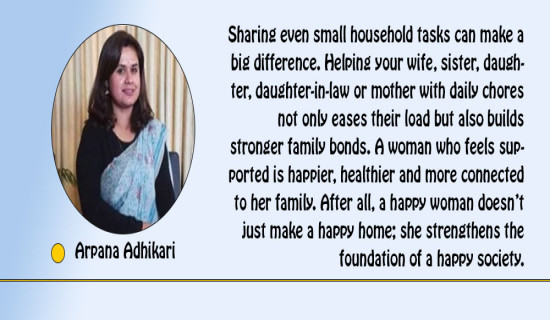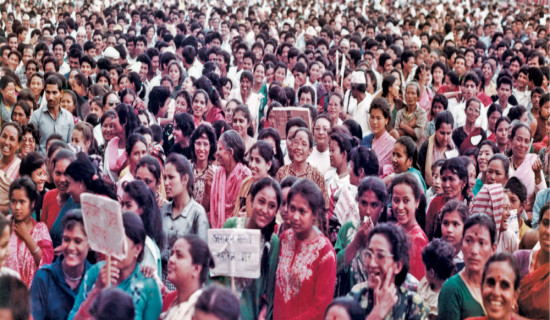- Saturday, 29 November 2025
Families of Kathmandu moving out of core areas to outskirts for comfort, security
Kathmandu, Feb. 16: Over the past few years, a noticeable trend has emerged in the Kathmandu Valley. Families from the core areas of the capital valley are now migrating to suburban areas in search of better living conditions.
Struggle for space
Sriram Thapa and his family moved to Lubhu, Lalitpur from Baluwatar, Kathmandu, three years ago. Their house in Baluwatar was built on five aanas of land, making it difficult for his six-member family, said Thapa.
His grandchildren had little space to play and were mostly confined indoors with gadgets.
To improve their living conditions, his family sold their property in Baluwatar and built a new house in Lubhu. They initially owned six anas of land there and purchased six more to construct a spacious home with a proper garden.
“We needed more space for our family. Living in a congested house was tough, especially for my grandkids,” said Thapa, a former school teacher. “Baluwatar had all the facilities, like hospitals and schools, nearby, but we wanted a better quality of life. However, buying a similar area of land there was beyond our means, so we moved here.”
A shift to suburban area for better living
Sachidananda Sharma, a local of Kamalpokhari, moved to Bhaisepati six years ago after renting out his house at a good price. With half of that rental income, he now leases a bungalow in Bhaisepati. “Living here is a stark contrast to Kamalpokhari, where my house was right by the roadside, leaving no space beyond the wall, not even to stand,” said Sharma.
“Now, my five-member family enjoy living in peaceful environment, away from the city’s chaos.” He added that having Mediciti Hospital, one of the best hospitals, gives a sense of security in case of health emergencies.
Similarly, Prabhat Bhusal and his family moved from Baluwatar to Budanilkantha five years ago. “We sold our six-ana land in Baluwatar and bought a ropani of land at Pasikot, Budanilkantha Municipality, fulfilling my long-held dream of having a spacious house with a garden.”
Bhusal said, “We chose this location for its blend of modernity and serene surroundings, along with renowned school and hospitals nearby.”
Rise of suburban housing developments
The growing demand of suburban housing is not limited to these families alone. Many others have followed suit, seeking a better quality of life and stronger sense of security and community. Hareram Baral, originally from Birgunj and a longtime resident of Sifal, is planning to move to Balkot, a Rose Village colony, an integrated housing settlement.
“I’ve lived here for almost 37 years. Since our house is now built in Balkot, we plan to move there within a couple of months,” Baral said.
He explained that his current location is easily accessible from all parts of the valley but it has grown very chaotic. “Our house is by the roadside, and my family is often disturbed by the noise from vehicles and foot traffic at the junction in front.” Baral highlighted the benefits of less pollution and better housing on the outskirts. “We chose Balkot for its peaceful environment and better community,” he added.
Min Ratna Bajracharya, a senior photojournalist, left his ancestral property in Chettrapati after the 2015 earthquake. “The fear of another quake in the congested settlement led us to rent our ancestral house and move to Budanilkantha, which offers a sense of security in the midst of nature,” he said.
Similarly, Reema Shrestha from Ason moved to Budanilkantha for her son’s health. “Our congested house in Ason lacked sunlight and water, and smoke from neighboring goldsmiths affected my son’s health. Since moving here, his health has improved,” she shared.
Initially, Shrestha struggled with her children’s school and being new to the community, but later found comfort. She and Bajracharya are neighbours in Ishan Colony near Deuba Chowk. “It was hard at first, but now we’re happy living close to nature,” Shrestha added
Bajracharya echoed similar sentiments despite the initial challenge of commuting to Hattiban for work. “Living with a sense of security was worth the commute that long,” he said.
Bishan Wagle, another neighbour in the colony who had shifted from Kalanki, noted that out of 25 houses in the colony, 15 families had moved from the core areas of Kathmandu.
Likewise, Bina Devkota and her family also moved to Green Hill City in Mulpani from Maitidevi. This is not just the story of Thapa, Sharma, Bhusal, Shrestha, Bajracharya, Wagle
and Devkota.
Many families have shifted to peri-urban area of Kathmandu Valley from the core areas of Kathmandu, either in search of peace, a better place, a good community, and better infrastructure, or by receiving a substantial amount from selling or renting their properties in the city’s core area.
Sociologists’ views on this
Sociologists attribute the migration of Kathmandu’s core residents to suburban areas primarily to socio-economic factors, whereas deteriorating quality of life in core areas has promoted many to opt living on the valley’s fringes.
Speaking to The Rising Nepal, sociologist Dr. Chaitanya Mishra stated that property partition, inadequate urban planning, congested buildings, pollution, traffic disorder, and the lack of open spaces have driven families to seek suburban communities with better infrastructure, security, and organised settlements.
According to him, property division is a key factor in this shift. When hereditary assets are divided among heirs, those who do not inherit land in the core city often buy property on the outskirts, as soaring real estate prices make central locations unaffordable. Because of this, many settles within an hour’s drive of their ancestral homes.
“The rise of integrated housing developments, offering modern infrastructure and amenities, has made suburban living particularly attractive to the younger generation and those living retired life,” he said.
Stating that some families of his circle have also opted for this trend, he said this shift reflets locals’ desire for improved living standard and safety.
Growing population
The growing population of the core city of Kathmandu has also attributed this shift. As per the National Population and Housing Census, Kathmandu’s annual population growth rate is 6.67 per cent.
Kathmandu, as an economic hub, has attracted many from outside the valley seeking opportunities, which has increased housing demand and rent.
As a result, the value of land in the city’s core areas has become unaffordable. This has led real estate developers to explore in suburban areas, as Bhaisepati, Budanilkantha, Mulpani, Sunakothi, Balkot, Ramkot, Tokha among others, Chairman of Nepal Land and Housing Developers Federation, Bishnu Prasad Ghimire.
Ghimire said the demand for homes in valley outskirts has surged due to affordable prices and clean and chaos free surroundings.
According to him, currently there are 56 housing communities in Kathmandu, 53 in Lalitpur and three in Bhaktapur district.
Real estate developers have opted to develop integrated settlements on the outskirts of the valley, considering the availability of land and reasonable prices.
Ghimire said mostly after the massive earthquake hit Nepal in 2015, locals have been driven to the outskirts of the valley.
Despite the growing popularity of integrated settlements, Ghimire expressed concern over the recent decline in the real estate business due to strict government measures.
He argued that unplanned settlements could lead to the loss of arable land, and advocated for integrated settlements to address the issues and urged the government to support this.
















